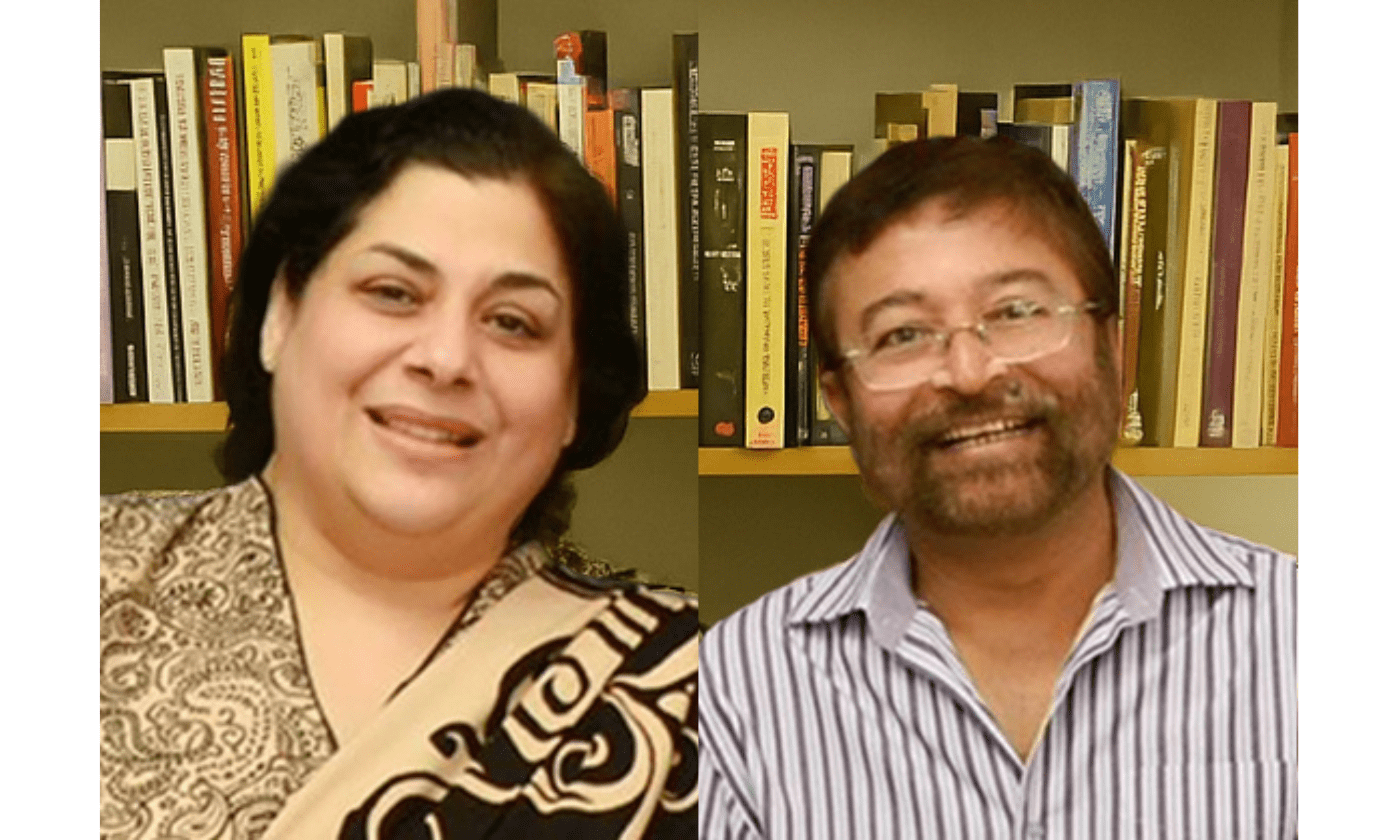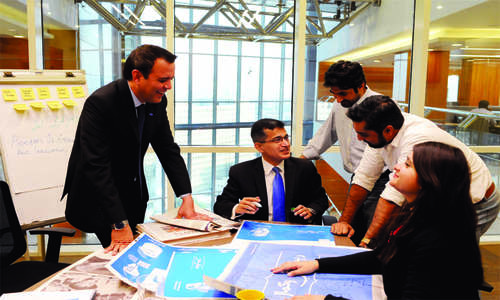“Design is a business”
First published in Aurora’s September-October 2004 edition.
You could travel the breadth of the world, and you would struggle to find two people in a successful working relationship who are so intrinsically different from each other. Once you work with them for a while, you discover that they are the original odd couple, their relationship, essentially, a study in contrasts. Tannaz Minwalla is boisterous, Mannan Hatim Ali placid; Tannaz is vociferous and – to the uninitiated – has an intimidating presence. Mannan is quieter, inclined to slip into a room rather than burst into it; Mannan suggests and seeks consensus, Tannaz is more forthcoming with her advice; Mannan is the good cop to Tannaz’s bad.
But for over 20 years, they have been the unlikely driving force behind a body of distinctive design work for a variety of clients. Creative Unit – the design house they both head – is unlike most you will come across on the local adscape. A refreshing office space, liberally white and tinged with splashes of artwork – conducive, you may argue, to intangible creative impulses – is housed with (in addition to the odd couple) 11 staff – a motley crew of veteran and upstart graphic designers, off-beat illustrators and, of course, the ‘hospitality’ squad, always on hand with an assortment of chais, samosas and other goodies. And there isn’t a client services executive in sight.
“The irritations of the middlemen in that sense are out. The minute we have to deal with so many middlemen, the relationship suffers. There is no hierarchy for clients to go through; it’s a direct approval system – very casual. You come in and we meet you, and we take it from there,” says Minwalla.
But it doesn’t mean they don’t understand the need to balance art with commercial requirements. They are both endowed with a considerable awareness of what will and won’t sell.
“Design is a business; that is the most important thing I tell everyone. We have no business training. A client once asked, “Where did you go to business school?” I replied that it has taken us nine years and he thought I meant that I had been to IBA evening classes for nine years. I said, “No, just at this desk. Every day is a learning experience. This is where the business sense comes from – experience,” asserts Minwalla.
Again, unlike a number of agencies, creative or full-service, staff turnover is low. They are a stable outfit and a large core of the current team has been there nearly 12 years.
“Many came to us with their portfolios and we hired them. They have grown on us and a very small number have grown out of us!” says Hatim Ali.
He adds, “Only a couple came to us from art school. Most were untrained but you wouldn’t be able to tell now. We are a team in the truest sense of the word. We may be able to think of something but to execute it, we need our team. It has to come together like that.”
Whether it is quick-fire Nasir, the comforting aura of the laidback Iqbal (“Why worry? The work has to be done and it will.”), the quirkiness of the illustrators Aamir and Imran (liberal with the ciggies), the soothing tones of Yousuf on the phone or the antics of Khurram, Rafique and Naushad (from darkroom operator to graphic designer and photographer extraordinaire), the atmosphere is not only rarely without its moments, but the work is infused with quality.
And to the outsider, it is the work that sets them apart. Their long and fruitful association with the DAWN Group of Newspapers has helped them establish a stronghold in publication design, especially their time as the Group’s in-house creative department in the eighties.
“Our greatest education has come from working with the DAWN Group and its various publications. We learnt the whole process of design and printing because the work was so hands-on then,” says Ali.
“The computer today is great but it is not perfect. We learnt how you align type and work it in with space – we learnt these basics at DAWN before computers were big. Doing Herald, month after month, cutting, pasting, etc., teaches you a fair bit,” adds Minwalla.
Handling three DAWN publications (as well as much of their communications) means this area of their work remains strong, but over the years, as they became a private limited company (in 1992) and developed a wider clientele, they have diversified the nature of their output.
“We got a lot of business from referrals and word-of-mouth; people passed our names to clients initially on the basis of the work they had seen,” explains Minwalla.
They got a “lucky break” with GlaxoSmithKline Beecham, designing their brochures and entering the pharmaceutical market and their reputation has since grown.
They also played a part in the fledgling days of the telecommunications industry in Pakistan, introducing the public to Instaphone, Wavetech (satellite dishes) and pagers with various promotional materials and advertising.
In the last five years, their annual reports business has also grown, starting off with the Central Depository Company.
“They are an intelligent client and they took on board our suggestions about changing the way annual reports look. We gave them a unique look and since then the way reports are made, I think, has changed,” contends Minwalla.
Creative Unit now boasts Unilever as a regular client – they design their in-house magazine Team,’ and bearing a hidden influence on their wider communication – as well as the British Council, who came to them after seeing their work for DAWN.
With IUCN on board as yet another client, Creative Unit branched out into book designing and it is a type of work that they are clearly proud of.
“The real hardcore work is often tedious, but the results make up for it,” says Hatim Ali.
They have, typically perhaps, worked on a diverse range of books; from Shahjee Risalo Ganj (where they had to paste verses and patterns by hand) with the then Minister for Culture, Tourism and Sports, Hamid Akhund, to the behemoth Holy Sinner: Sadequain masterpiece, and culminating, so far, with the quintet of publications launched alongside the DAWN Group’s Jewel in the Crown: Karachi Under the Raj 1843-1947 exhibition at Mohatta Palace.
What next? The future is excitingly unclear but in the past can be found some pointers. Both have no qualms in being different. Minwalla joined art school straight after her O-levels: “No one else knew what they wanted to do, so they took their A-levels. I went straight to art school after my substitute art teacher in class nine opened my eyes to art. Till then I hated art class.”
Hatim Ali joined the same school – the Central Institute of Arts and Crafts at the Arts Council – two years prior to Minwalla, after his intermediate. He took evening classes at a time when art as a vocation was taken even less seriously than it is today. They both knew of each other rather than knowing each other.
“Mannan was the quiet one, like he is today,” reveals Minwalla. Hatim Ali quips, “And she was in awe of my work.”
The school counts Noorjehan Bilgrami among its alumni, as well as Imran Mir, now Chief Executive of The Circuit. And it was Mir who brought the two together professionally. Mir recruited Hatim Ali to IAL immediately after he completed his diploma, having been impressed with his college work. He didn’t stay too long at the agency, but he remained in the loop, working on a journal for Pakistan Customs with Mir’s wife, Nighat. “This is how I got into publications initially.”
Minwalla, meanwhile, graduated and also started work at IAL, although Hatim Ali had left by then. “I chose IAL because the office was close to my home in Bath Island! But it was where I learnt the ropes of the agency business, the politics, the clients, and the art of selling.”
When Mir moved to head a new creative department at DAWN in May 1982 – set up to revamp the group’s image and to take advantage of new printing technologies – he took Hatim Ali with him. He soon convinced a restless Minwalla to join them, which is where this story really begins.
What is next should then be the real question. Having worked together for 22 years and having straddled both pre- and post-computer graphics design ages with alarming comfort, there isn’t much that Creative Unit hasn’t done. And when you hear Minwalla insouciantly assert that the most memorable piece of work is always the next one, you get the sense that there isn’t much they won’t be able to achieve.


Comments (0)